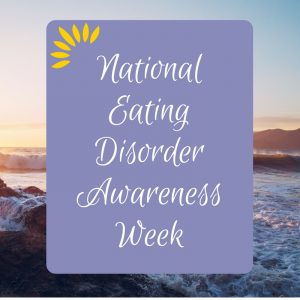It’s Time to Talk About It #NEDAwareness
 National Eating Disorder Awareness (NEDAwareness) Week starts this Sunday, February 26th and runs through March 4th. The theme of this year’s NEDAawareness Week is It’s Time to Talk About It. The National Eating Disorder Association wants to encourage you and everyone else to talk about eating disorders.
National Eating Disorder Awareness (NEDAwareness) Week starts this Sunday, February 26th and runs through March 4th. The theme of this year’s NEDAawareness Week is It’s Time to Talk About It. The National Eating Disorder Association wants to encourage you and everyone else to talk about eating disorders.
Eating disorders affect everyone, regardless of gender, ethnicity, age, socioeconomic status, sexuality, or background. In the United States, 20 million women and 10 million men suffer from a clinically significant eating disorder in their life. With today’s media and advertisements showing stick-thin models as the “right” way to look, it makes sense why so many people may develop an eating disorder. A negative body image can lead to a serious eating disorder.
Type of Eating Disorders
The two most commonly talked about eating disorders are bulimia and anorexia nervosa. However, there is also binge-eating disorder, gymorexia, and orthorexia.
- Bulimia is the act of bingeing and purging. A person with bulimia will often consume more calories in one sitting than they would in a normal day. This bingeing leads to guilt and self-shaming which turns into purging. People with bulimia are often a healthy weight but are struggling on the inside.
- Anorexia nervosa is a disease that tricks your mind into seeing a distorted, often larger, version of yourself. A person with anorexia starves themselves, forfeiting calories as well as many vitamins and minerals that are necessary to keep their body running. People with anorexia typically appear thin and fragile, but that isn’t always the case.
- Binge-eating disorder is very similar to bulimia, but they don’t purge. A person with binge-eating disorder engages in uncontrollable, continuous eating past the point of fullness. This is the most common eating disorder in the United States.
- Orthorexia is an “unhealthy obsession” with healthy eating. A person with orthorexia nervosa has a fixation on righteous eating and it usually starts as an innocent attempt to eat more healthfully.
Regardless of which eating disorder is exhibited, those who are struggling with one seek ways to change their body. Today’s media makes it hard to find happiness and peace in your own body, so it is important to promote your own body positivity.
Here are five ways to stay body positive:
- Appreciate all that your body does for you. It carries you closer to your dreams and aspirations.
- Think of 10 of your best qualities that you like about yourself, not weight or appearance related. Beauty on the inside is much greater than beauty on the outside.
- Surround yourself with a strong support system that is body-positive.
- Wear clothing that makes you feel comfortable and confident.
- Give yourself “me” time, treat yourself to a massage, or manicure, or relax and read your favorite book. Taking the time to take care of yourself is an important step to stay body-positive.
Remember, eating disorders do not discriminate. Awareness is the first step to conquering these disorders


Leave a Reply
Want to join the discussion?Feel free to contribute!